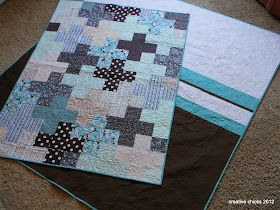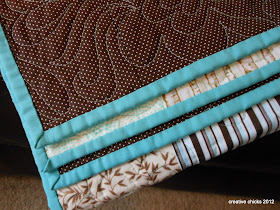The third method you can use to finish off the neck opening of your t-shirt is by making an actual facing. This method probably works best when making a boatneck style, V-neck or Square neck tee. Tiffany's boatneck shirt below has been faced at the neck opening.
Usually facings are interfaced to give the piece a bit more body.
There is interfacing you can buy that is specifically made for knit fabrics.
We found ours at Jo-Ann's, on the bolt, buy by the yard, in their interfacing section.
It's purpose: to add shape while maintaining drapability.
This is what it looks like.
Iron-on on one side.
But still able to stretch a bit.
Tiffany just introduced me to this and let me say it is AWESOME stuff.
I don't normally make faced necklines on t-shirts because using regular interfacing wasn't my fav. I didn't love it. However, this knit interfacing works up beautifully and now after having tried it I will use it more and make more tees with different shaped necklines.
If ever you want a facing for some shirt that doesn't specifically require one, or doesn't have a pattern piece included, just trace the neck opening cutting line of both the front and back pattern pieces and then cut about 3 inches below that line again to form the facing.
As with all facings, after attaching the iron-on interfacing, pin right sides together and sew.
This shows her square neck tee pinned together and ready to sew.
After sewing, clip curves and then turn and flip facing in towards the inside of the shirt.
Iron a little if you need to. Just make sure your iron is on a cooler setting so you don't melt the fabric (depending on the polyester content of the fabric)
Topstitch the facing in place.
Then trim the excess.
Below is Tiffany's finished facing, topstitched and trimmed from the inside of the shirt.
If you don't want to you don't have to finish the raw edge of the facing.
It won't ravel, so unless you have a serger, I wouldn't worry about it at all.
Finished tank top below.
Tiffany also faced the armhole openings using the same method.
And here is how she normally wears her tank tops.
With a pretty little cardigan.
She lives in S. Utah where it gets extremely hot.
But then going in and out of A/C buildings can make it chilly too.
So their best bet is wearing layers.
This is her go-to pattern (discontinued) for the square neck tank top.
However, you can change the neckline yourself with any tank top pattern you have.
Or if you have a square neck t-shirt pattern and want a tank top instead, just eliminate the sleeves.
You may need to adjust the opening of the armhole slightly for your own comfort level.
Depending on how you plan on wearing it you can either face the armhole openings, put a binding on the edge, or if you plan on only wearing it under something leave the armhole edge raw, unfinished.
I've actually done this on a couple store bought shirts that I preferred as tank tops
to wear layered with other shirts. (I don't want the double layer of sleeves)
Just cut off the sleeves and called it good. The unfinished knit edge will not ravel.
________________
Note:
Besides this facing method you can also check out the binding method and ribbing method to finish off the neck opening.

















































